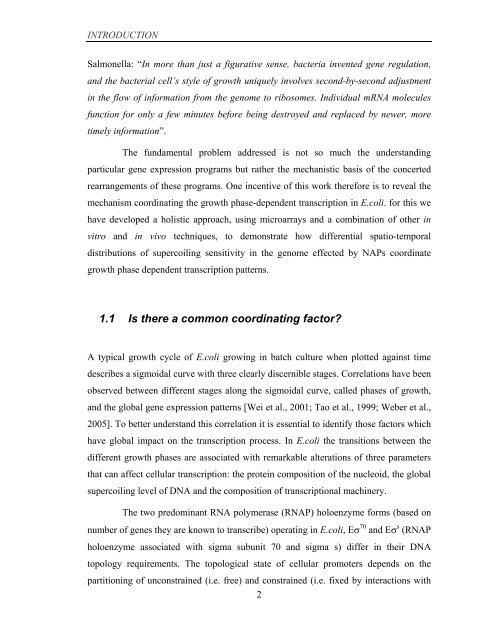Coordinated regulation of gene expression by E ... - Jacobs University
Coordinated regulation of gene expression by E ... - Jacobs University
Coordinated regulation of gene expression by E ... - Jacobs University
You also want an ePaper? Increase the reach of your titles
YUMPU automatically turns print PDFs into web optimized ePapers that Google loves.
INTRODUCTION<br />
Salmonella: “In more than just a figurative sense, bacteria invented <strong>gene</strong> <strong>regulation</strong>,<br />
and the bacterial cell’s style <strong>of</strong> growth uniquely involves second-<strong>by</strong>-second adjustment<br />
in the flow <strong>of</strong> information from the genome to ribosomes. Individual mRNA molecules<br />
function for only a few minutes before being destroyed and replaced <strong>by</strong> newer, more<br />
timely information”.<br />
The fundamental problem addressed is not so much the understanding<br />
particular <strong>gene</strong> <strong>expression</strong> programs but rather the mechanistic basis <strong>of</strong> the concerted<br />
rearrangements <strong>of</strong> these programs. One incentive <strong>of</strong> this work therefore is to reveal the<br />
mechanism coordinating the growth phase-dependent transcription in E.coli. for this we<br />
have developed a holistic approach, using microarrays and a combination <strong>of</strong> other in<br />
vitro and in vivo techniques, to demonstrate how differential spatio-temporal<br />
distributions <strong>of</strong> supercoiling sensitivity in the genome effected <strong>by</strong> NAPs coordinate<br />
growth phase dependent transcription patterns.<br />
1.1 Is there a common coordinating factor?<br />
A typical growth cycle <strong>of</strong> E.coli growing in batch culture when plotted against time<br />
describes a sigmoidal curve with three clearly discernible stages. Correlations have been<br />
observed between different stages along the sigmoidal curve, called phases <strong>of</strong> growth,<br />
and the global <strong>gene</strong> <strong>expression</strong> patterns [Wei et al., 2001; Tao et al., 1999; Weber et al.,<br />
2005]. To better understand this correlation it is essential to identify those factors which<br />
have global impact on the transcription process. In E.coli the transitions between the<br />
different growth phases are associated with remarkable alterations <strong>of</strong> three parameters<br />
that can affect cellular transcription: the protein composition <strong>of</strong> the nucleoid, the global<br />
supercoiling level <strong>of</strong> DNA and the composition <strong>of</strong> transcriptional machinery.<br />
The two predominant RNA polymerase (RNAP) holoenzyme forms (based on<br />
number <strong>of</strong> <strong>gene</strong>s they are known to transcribe) operating in E.coli, Eσ 70 and Eσ s (RNAP<br />
holoenzyme associated with sigma subunit 70 and sigma s) differ in their DNA<br />
topology requirements. The topological state <strong>of</strong> cellular promoters depends on the<br />
partitioning <strong>of</strong> unconstrained (i.e. free) and constrained (i.e. fixed <strong>by</strong> interactions with<br />
2
















